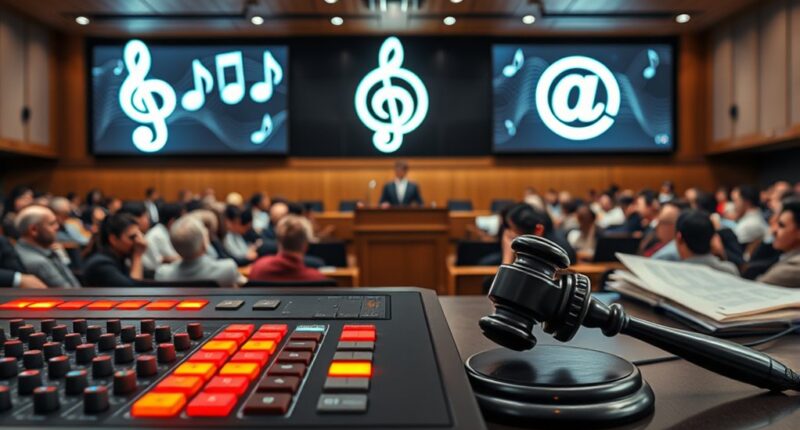In 2025, understanding fair use and sampling involves recognizing that courts look for transformative work and context when evaluating legality. You need to take into account if your sample adds new meaning or criticism, rather than copying recognizable parts. Licensing is often the safer choice to avoid disputes, but fair use can apply in specific cases. If you want to guarantee your work is protected, exploring recent case studies reveals valuable insights into legal boundaries and creative flexibility.
Key Takeaways
- Courts assess whether sampling is transformative, adding new meaning or critique, to determine fair use eligibility in 2025 cases.
- Case studies reveal that minimal, non-recognizable sampling favors fair use, while direct replication often leads to infringement claims.
- Recontextualizing original works through commentary or parody strengthens fair use defenses in legal disputes.
- Successful fair use defenses depend on case-specific factors like purpose, amount used, and market impact.
- Many artists opt for licensing agreements to avoid legal risks, highlighting the evolving importance of clear sampling clearance in 2025.

Have you ever wondered how musicians and producers incorporate snippets of existing songs into new works without facing legal trouble? It’s a fascinating process rooted in understanding fair use, music licensing, and intellectual property laws. When artists sample a piece of a song, they’re tapping into someone else’s creative work, which is protected by intellectual property rights. Without proper clearance, that act can lead to lawsuits and hefty fines. But there’s a nuanced legal landscape that allows for some sampling without permission — fair use. This doctrine lets creators use small portions of copyrighted works for commentary, criticism, or parody, but it’s not an open license for all sampling.
In 2025, the line between fair use and infringement remains a hot topic, especially as courts continue to refine how sampling fits into this framework. For instance, some producers navigate this landscape by relying on fair use when their sampling is transformative—meaning it adds new meaning or context that wasn’t in the original. If your work merely copies a recognizable part of a song without significant alteration, it’s less likely to qualify as fair use. Conversely, if your sampling recontextualizes or critiques the original, courts might see that as protected speech. Still, it’s a risky gamble because fair use is determined case-by-case, considering factors like purpose, nature, amount used, and the effect on the market.
Often, artists and producers prefer to secure music licensing agreements upfront. These licenses give legal clearance to sample or incorporate parts of a song, ensuring your work respects the original creator’s intellectual property rights. Licensing can be complex and costly, but it provides peace of mind and avoids legal disputes. Some creators opt for licensing because they want to avoid the unpredictability of fair use defenses, especially when their samples are substantial or commercially driven.
In 2025, the evolving legal landscape encourages creators to be more intentional with their sampling practices. Whether relying on fair use or securing licensing, respecting intellectual property rights remains essential. The importance of understanding copyright law, fair use parameters, and licensing options helps you avoid legal pitfalls and foster respectful, creative collaboration. As technology makes sampling easier, legal boundaries become even more critical. Ultimately, knowing when and how you can sample legally shapes your ability to innovate without risking costly legal battles.
Frequently Asked Questions
How Does AI Influence Fair Use Analysis in Sampling Cases?
AI influences fair use analysis in sampling cases by providing AI analysis that evaluates how much of the original work is used and its transformative nature. However, you should watch out for algorithmic bias, which may skew results or overlook nuances in context. This means AI can assist but isn’t definitive, so your case still needs human judgment to guarantee fair use considerations are accurately assessed.
Are International Sampling Laws Harmonizing in 2025?
Imagine a global symphony where every country plays in tune; that’s what international agreements aim for, fostering legal harmonization. In 2025, these efforts are progressing, but full harmonization remains elusive. You’ll find some nations aligning their sampling laws, yet others hold firm to their traditions. While strides are made, you still need to navigate each country’s unique legal notes carefully, avoiding discord in your sampling practices.
What Role Do Social Media Platforms Play in Sampling Disputes?
Social media platforms play a pivotal role in sampling disputes by influencing viral trends and enabling user enforcement. When users share samples without proper rights, platforms often face pressure to remove content quickly, impacting legal actions. You might notice that viral trends spread sampling disputes rapidly, with users demanding accountability. Platforms must balance fostering creativity and protecting intellectual property, often acting as gatekeepers to prevent unauthorized sampling from going viral.
Can Fair Use Defenses Vary Across Different Music Genres?
Sure, fair use defenses do vary across genres, thanks to genre-specific defenses and stylistic distinctions. You might find that hip-hop artists are more protected when sampling for artistic expression, while classical composers face stricter scrutiny. So, your legal shield depends on the genre’s unique stylistic nuances, making fair use a flexible, genre-tuned tool rather than a one-size-fits-all armor. Keep this in mind when crafting your next remix or composition.
How Do Courts Evaluate the Commercial Impact of Sampling?
Courts evaluate the commercial impact of sampling by examining whether the sample causes monetary damages or acts as a market substitution. You should understand that if the sampled work negatively affects sales or replaces the original’s market, it’s likely to be viewed as infringing. The court considers how the sampling influences the potential revenue of the original, weighing if it diminishes value or causes significant market harm.
Conclusion
As you navigate the complex landscape of fair use and sampling, remember that understanding the boundaries, respecting the creators, and balancing innovation are essential. You must recognize the importance of context, consider the purpose, and evaluate the impact. By doing so, you protect your artistry, honor original work, and foster a fair creative environment. In this delicate dance of rights and innovation, clarity, responsibility, and respect will guide your path forward.








